Elastic Knee Support, Black
In Stock
The Mueller Elastic Knee Support combines robust knee support with unrestricted range of motion while featuring a contoured design that prevents bunching in the popliteal area behind the knee.
Knee joint swelling, also known as knee effusion, is a common symptom that can be caused by various factors. It occurs when excess fluid accumulates in or around the knee joint, leading to swelling, discomfort, and limited mobility. Understanding the potential causes, obtaining an accurate diagnosis, and implementing appropriate treatment strategies are essential for managing knee joint swelling effectively.
This article explores the possible causes, diagnosis, and treatment options for knee joint swelling.
Knee joint swelling can be caused by several factors, including:
Acute injuries, such as ligament sprains, meniscus tears, or fractures, can result in knee joint swelling due to damage to the structures within the knee joint.
Osteoarthritis is a degenerative joint condition that can lead to the breakdown of cartilage in the knee joint. In response to the damage, the body may produce excess fluid, leading to swelling. You can read about the treatment of osteoarthritis here.
Rheumatoid arthritis is an autoimmune disease characterized by chronic inflammation. It can cause synovitis, an inflammation of the synovial membrane, leading to knee joint swelling.
Bursitis occurs when the bursae, small fluid-filled sacs that cushion the knee joint, become inflamed. This can lead to swelling and discomfort in the knee.
Gout is a form of arthritis caused by the buildup of uric acid crystals in the joints. When the knee joint is affected, it can result in swelling, redness, and intense pain.
In rare cases, infections, such as septic arthritis or cellulitis, can cause knee joint swelling. These conditions require immediate medical attention.
To diagnose the cause of knee joint swelling, healthcare professionals may perform the following procedures:
A detailed discussion of symptoms and medical history provides important insights. A physical examination of the knee joint includes assessing for swelling, tenderness, range of motion, and signs of inflammation.
X-rays, magnetic resonance imaging (MRI), or ultrasound may be ordered to visualize the structures within the knee joint, assess for fractures, ligament injuries, or signs of arthritis.
In certain cases, a procedure called joint aspiration may be performed, where a small amount of fluid is removed from the knee joint using a needle. The fluid can be analyzed for infection, inflammation, or other underlying causes.
The treatment approach for knee joint swelling depends on the underlying cause and severity of the condition. Treatment options may include:
Rest, ice, compression, and elevation (RICE) therapy is often recommended to reduce swelling and manage pain. Resting the knee, applying ice packs, wearing a compression bandage, and elevating the leg can help alleviate symptoms.
Over-the-counter nonsteroidal anti-inflammatory drugs (NSAIDs), such as ibuprofen, may be used to reduce pain and inflammation. In some cases, corticosteroid injections may be administered directly into the knee joint to provide short-term relief.
A physical therapist can design a customized rehabilitation program that includes exercises to strengthen the muscles around the knee joint, improve range of motion, and promote stability and flexibility.
Using assistive devices, such as crutches or knee braces, can provide support, reduce weight-bearing stress, and promote proper alignment of the knee joint during the healing process. A hinged knee brace may be especially helpful in this regard.
In severe cases or when conservative treatments fail to alleviate symptoms, surgical intervention may be necessary. Procedures can range from arthroscopic surgery for repairing or removing damaged structures to joint replacement surgery in advanced cases of arthritis.
While not all cases of knee joint swelling can be prevented, there are measures that can help reduce the risk. These include:
Excess weight can put added stress on the knee joint, increasing the risk of developing conditions such as osteoarthritis. Maintaining a healthy weight can help minimize strain on the joint.
Engaging in regular exercise and activities that promote knee joint strength, flexibility, and stability can help prevent injuries and maintain joint health.
Whether in sports or daily activities, using proper techniques and protective gear can reduce the risk of knee injuries.
Avoid excessive or repetitive activities that may strain the knee joint, leading to inflammation and swelling.
Pay attention to any signs of discomfort or pain in the knee joint. Resting, modifying activities, or seeking medical attention when necessary can help prevent further damage or worsening of symptoms.
Knee joint swelling is a common symptom with various potential causes, ranging from acute injuries to chronic conditions.
Obtaining an accurate diagnosis through a comprehensive evaluation is essential for determining the underlying cause and guiding appropriate treatment. Following a tailored treatment plan, which may include rest, medication, physical therapy, or surgery, can help manage symptoms, reduce inflammation, and improve knee joint function.
By implementing preventive measures and maintaining overall joint health, individuals can reduce the risk of knee joint swelling and related conditions, promoting long-term knee joint well-being.

In Stock
The Mueller Elastic Knee Support combines robust knee support with unrestricted range of motion while featuring a contoured design that prevents bunching in the popliteal area behind the knee.

Typically Ships in 3-5 Business Days
The McDavid Knee Sleeve/4-Way Elastic With Gel Buttress has a 4-way stretch elastic material that allows for increased compression and fit without heat retention.
Level 2: Advanced Protection – Moderate support and relief from pain associated with arthritis, bursitis and tendonitis

Typically Ships in 3-5 Business Days
The McDavid Knee Sleeve / 4-Way Elastic With Gel Buttresses & Stays has a 4-way stretch elastic material that provides increased compression and a closer fit without heat retention.
Level 2: Advanced Protection – Moderate support and relief from pain associated with arthritis, bursitis and tendonitis

Typically Ships in 3-5 Business Days
The McDavid Knee Support With Stays has a padded buttress that supports the patella. Spring steel stays provide reinforced support and elastic hook and loop straps ensure an outstanding fit. There is an exterior layer of nylon fabric for durability.
Level 2: Advanced Protection – Moderate support helping to relieve symptoms and aid recovery from chondromalacia, patellar subluxation and tendonitis

In Stock
The Mueller OmniForce Knee Stabilizer AKS-500 aims to alleviate moderate knee pain and instability and features 3 coiled alloy stays and soft, comfortable and breathable fabric to provide superior moisture management. Replaces the MU4540 and MU230 knee supports.
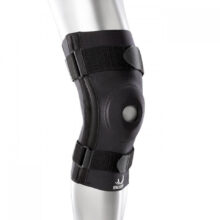
In Stock
The Bio Skin Patella Stabilizer is an excellent choice to treat anterior knee pain and other knee problems. Constructed from Bio Skin’s patented, breathable materials, the patella stabilizer gives excellent compression to control swelling and decrease pain in the knee. The donut shaped buttresses stabilize the patella and help keep swelling away from the knee joint. The brace is comfortable to wear and stays in place even during vigorous activity.
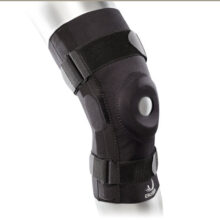
In Stock
Relief and support for sore knees with performance foam patellar ring
The Bio Skin Patella Stabilizer with Conforma Hinge is an excellent choice to treat anterior knee pain and other knee problems. Constructed from Bio Skin’s patented, breathable materials, the patella stabilizer gives excellent compression to control swelling and decrease pain in the knee. The donut shaped buttresses stabilize the patella and help keep swelling away from the knee joint. The brace is comfortable to wear and stays in place even during vigorous activity.
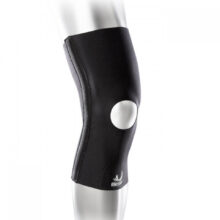

In Stock
Medium-level compression for minor pain and instability
The Bio Skin Standard Knee Skin provides optimal compression to decrease knee pain, control swelling, and increase proprioception. The design features a two-panel construction so there is no seam in the sensitive area behind the knee. Bio Skin’s unique, patented materials make the brace breathable and comfortable, and wicks moisture away from the skin. All Bio Skin materials are 100% neoprene free and latex free!

Typically Ships in 1-2 weeks
Silicone ring helps keep swelling off the joint
The Bio Skin Visco Knee Skin with Conforma Hinge is an excellent all-purpose knee support. The Visco gel ring around the patella provides passive massage to remove swelling and decrease knee pain. The brace is comfortable enough to wear all the time and is very useful a few weeks after knee surgery to control swelling and speed recovery. Constructed fromBio Skin’s patented, breathable materials, the Visco Knee Skin gives excellent compression. Finger loops make application easy.
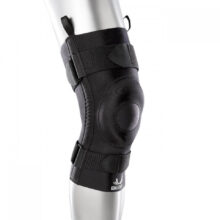

In Stock
Silicone ring helps keep swelling off the joint
The Bio Skin Visco Knee Skin with Thigh & Calf Straps is an excellent all-purpose knee support. The Visco gel ring around the patella provides passive massage to remove swelling and decrease knee pain. The brace is comfortable enough to wear all the time and is very useful a few weeks after knee surgery to control swelling and speed recovery. Constructed fromBio Skin’s patented, breathable materials, the Visco Knee Skin gives excellent compression. Finger loops make application easy.
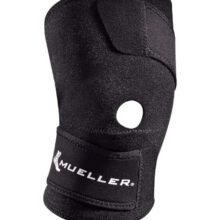
In Stock
The Mueller Sports Medicine Wraparound Knee Support is an easy on/off knee support that will provide support to weak, unstable or injured knees and improve blood circulation, courtesy of its neoprene blend. Replaces the MU4532 Knee Support.